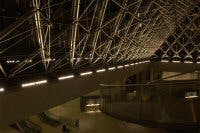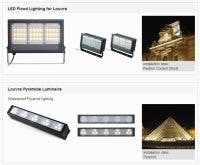The first stage involves the lighting in the iconic central Pyramid, as well as the three surrounding pyramidions (small pyramids) and a section of the façade of the Colbert pavilion, part of the main museum building.
The lighting was switched on during a ceremony on December 6 by Norio Sasaki, president and CEO of Toshiba Corporation, and Henri Loyrette, Director of the Louvre Museum.
The partnership between Toshiba and the Louvre Museum, which will run until 2023, was first announced in July 2010. In the next phases of the project the remaining facades of the Napoleon Court will be completed in the first half of 2012, and the courtyard will follow in 2013.
Six different fixture types were purpose-designed for the Louvre installation. The lighting had to meet various technical specifications, but also meet the more subjective and aesthetic requirements of the museum Director and France’s Historical Monuments Committee.
The fixtures used inside the Pyramid have a color temperature of 2700K, and are IP65-rated in case of water ingress during storms (there are no artworks beneath the pyramid!). The 15-LED fixtures replaced fittings that contained five 20-watt metal-halide lamps. The luminous flux remained the same, at just over 1300 lm, but the overall power consumption decreased from 120W to 29.5W.








